

This paper was the first part of a joint presentation given at the American Institute for Conservation (AIC) General Session, Nashville, June 9, 1994. The second section addressed the issue of recognizing and saving valuable publishers' bindings. Related publications by the same authors are:
Library conservators are re-evaluating their approach to repair of the books and pamphlets that make up a library's general collections. Within the Library Collections Conser-vation Discussion Group (LCCDG), which has emerged as the principal forum in which this inquiry is taking place, dialog revolves around basic guidelines of practice. How can we accomplish the greatest good for the largest portion of the collection? What techniques are available to us? What can be learned from the failure of older approaches? How economical are our routines for selecting, sorting, and repairing? And finally, do repair technicians have the necessary training, resources, and support they need to perform their jobs?
The purpose of this Discussion Group is to foster improvements in the management and implementation of conservation programs for non-rare research library collections. For the most part, participants are library conservators from the Book and Paper Group, book repair technicians, and preservation administrators responsible for repair programs.
In addition to scrutinizing technical specifications, the Group addresses issues such as:
LCCDG has attempted a number of nontraditional activities within the AIC. The Group, which began informally with discussions among interested members of the Book and Paper Group, was asked by the AIC Board to become a Special Interest Group, and has recently agreed to rejoin the Book and Paper Group as a Sub-specialty Group. These changes in status reflect growing pains occurring over the past four years as conservators committed themselves to formally expanding the role of book conservation to include book repair.
In the process, LCCDG has begun to influence the library profession through liaison activities with the Amer-ican Library Association. We are grateful to AIC for its generous support of those activities.
Library preservation's goal is to extend the useful life of each item in the collection for as long as it is needed to satisfy the institution's objectives. How a damaged book is preserved depends upon its condition, use, value, and structure. Book repair represents only one component of a comprehensive approach to library preservation.
In determining an item's disposition, brittle material may be microfilmed or photocopied, while rare items are sent to a conservator. In the general collection, those damaged books with ample inner margins printed on durable paper can be sent for commercial binding. The range of other damaged, non-rare materials are destined for in-house repair.
Books in the general collection are used incessantly and in ways undreamed of for rare materials, as anyone will testify who has seen them inside a book drop. Consequently, when we talk about book repair we imply large quantities of books that must be handled post-haste to meet user needs. And, despite the growing clamor about a "paperless society," approximately 50,000 titles are published each year in the U.S. alone. Of the titles added to research library collections, most are intended for permanent retention.
Book repair provides three primary services to the library. It offers a low cost source for simple treatments such as cloth spine repairs, paper repairs, and shelf preparation procedures including pamphlet binding. Its onsite location keeps books accessible during the repair process and allows books to be handled on a rush basis. Additionally, an in-house repair program provides the capability of performing complex or one-of-a-kind treatments most commercial binderies are reluctant to take on.
How does a repair program achieve the goal of routinely providing high quality repairs that function well and are at once neat, quick, tough, and non-damaging? To begin with, selection for treatment is primarily "use" driven. Items are selected for repair when they are returned from circulation or before being reshelved after use in the library. Work flow and organization are also critical elements to a successful program. Materials exhibiting the same type of structural failures are repaired in batches using a standardized approach that Glen Ruzicka calls "treatment to specification." This approach contrasts with the single-item treatments generally associated with rare book conservation. Efficiency is gained by applying a standard set of techniques to groups of material suffering similar problems, allowing a well-trained supervisor to coordinate the work of a large number of technicians or student employees. Furthermore, there is a growing consensus that written treatment specifications, in conjunction with the date of treatment routinely recorded in the finished book, can function as treatment documentation.
A distinguishing feature of book repair programs is that the work is not performed by conservators but by paraprofessional repair technicians and students working alongside and tutored by library conservators. This cooperative association is fairly recent, because in libraries, the book menders came decades before the conservators. When preservation departments were formally organized in academic research libraries, it was fairly common practice to place one conservator in charge of repair for both general and special collections materials. The conservator often inherited a self-taught work force with many years experience and a bindery that was minimally equipped.
Improving the quality of repair became a priority, so the conservator introduced better materials, non-damaging techniques, and more efficient work methods. However, book repairers were already well-versed in the unique demands of general collections repair. They were used to working with large quantities of material, to meeting quotas and deadlines, and being responsive to patron needs.
Conservation technicians are the key to the efficient operation of a book repair unit. They become highly skilled and quick because they do a large volume of repetitive work. But paraprofessionals do more than simply bind books. Under the supervision of the conservator, they work independently to organize and run daily operations. They sort material for treatment, schedule work to ensure that turnaround times are met, stock and order supplies, maintain equipment and work effectively with vendors.
In academic library settings, repair work is often accom-plished by a combination of full-time conservation technicians and student employees. Students are generally assigned to a specific type of repair, for example making protective enclosures, and are taught, supervised and assigned work by the conservation technicians. Contrary to popular belief, students can perform quite complicated binding procedures without years of training. Furthermore, they're a lively, intellectually stimulating addition to any conservation lab.
It is the conservator's role to contribute not only technical skills, but organizational and managerial skills to paraprofessional staff. Conservators can encourage technicians to participate fully in the library organization: to attend library functions and to serve on committees. But most of all, conservators can facilitate staff development. They can seek financial support to offer paraprofessionals additional training. For example, in the past several years, an increased number of conservation technicians attended both AIC and the Guild of Book Workers annual Seminar on Excellence in Bookbinding.
The positive results achieved in research libraries using paraprofessionals should encourage others. In fact, we hope the work of codifying acceptable standards for training paraprofessionals goes forward with AIC. It is possible that paraprofessional staff in many institutions could be used to greater advantage.
To date, the LCCDG has organized two events to review treatment specifications for the full range of book repair activities. The first, in 1992 at the annual meeting in Buffalo, included a display of 150 linear feet of repair work made up of samples contributed by 25 practitioners from across the U.S. and Canada. Each sample was accompanied by an identification label that described salient features of the treatment specification, including a description of the technique and materials used, the type of problem it was designed to overcome, the average time it took to execute, the cost of materials, and the number produced by the institution per year.
Exhibitors also contributed written institutional profiles, which were significant in that they constituted a record of that meeting and disclosed, often for the first time, the historical development of many preservation programs together with descriptions of current book repair practices. Two versions of these profiles were subsequently published: one in the Book and Paper Group Annual and the other as an Association of Research Libraries publication distributed to library directors in the more than 106 ARL libraries in North America. These publications helped make our work more accessible to both the library and conservation communities, and focused attention on a group that typically receives little recognition in libraries.
Most significantly, the Buffalo exhibit provided the first opportunity for most participants to examine book repair techniques produced by other major repair programs and to exchange information. What became immediately clear from the cross section of work exhibited is that nationally, book repair procedures have evolved with much in common. What also became clear was that the basic "core repair techniques" were not diverse enough to meet all the needs of general collections repair. Book conservators and technicians who attended felt the "trade show" of bookbinding options resulted in a healthy exchange of creative ideas.
LCCDG reconvened at the annual meeting in Denver, 1993. Again, participants brought book repair samples. This time, LCCDG members were organized into groups focusing on a specific topic, such as cloth rebacking, case binding, or collection maintenance for leather bindings. Repair samples were distributed for examination. Each group spent the morning reviewing and selecting techniques that represented the best solutions to repair problems. They were asked to prepare a brief statement outlining the group's topic and scope, the objective of the repair, the selection criteria, the treatment specification, and applicability.
Along with onsite photographic documentation, these "scope notes" formed the basis for our book repair manuscript which is under contract for publication with the American Library Association.
While there was much consensus, everyone in the room discovered at least one thing to be shocked by or opposed to! For some, it was the amount of time allotted to certain techniques. For others, it was the range of materials treated, including 18th century leather books. We mention this because so often our perception of what is appropriate is bounded by the context in which we practice--;that is to say, the needs, constraints and resources of our home institution. It was an enlightening experience for us to exhibit the full range of problems and techniques available to our profession and discuss the issues pertinent to our practice. We are forced to admit that library administrators are not the only ones suffering from an outdated view of book repair. We, too, are guilty of restricting our vision! But the dialogue is open and we are ready to learn.
Broadly speaking, the categories of treatment performed in a repair program consist of mending the text, repairing damaged bindings and restoring cover-to-text attachment, rebinding texts, preparing new acquisitions to be durable enough for shelving, and constructing protective enclosures.
The past few years have witnessed several innovative approaches to the most common repair problem: reattaching detached boards. It is perhaps in this area that the practice of the "new book repair" can be most clearly understood.
Prior to the introduction of these techniques, approaches to reattaching boards were clearly dependent on who was doing the work and what material was being repaired. In book repair, four or five quick styles of cloth rebacking were common for circulating books, and book technicians never repaired leather books. Sometimes this led to inappropriate repairs or books being boxed with their boards detached. Conservators, on the other hand, performed full scale restoration of cloth or leather, a time-consuming process consisting of dyeing materials to match the original, and lifting both covering material and endpapers.
Fortunately, the following techniques revolutionized board attachment for both conservators and technicians.
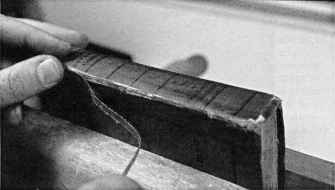 Fig. 1. Colored
Japanese paper hinge repair, in progress.
Fig. 1. Colored
Japanese paper hinge repair, in progress.
Don Etherington of ICI designed a treatment for the repair of
damaged joints on cloth or leather bindings. Colored Japanese paper
is attached to the joints or headcaps of the binding, and
consolidated with an acrylic wax. With this 20-minute technique,
libraries can effectively preserve significant original bookbindings
for no more than the cost of a standard spine repair.
In libraries with older collections, leather books are
increasingly becoming a problem. Tony Cains, David Brock and Robert
Espinosa each developed expeditious methods of "board tacketing" to
reattach leather boards to their bindings.
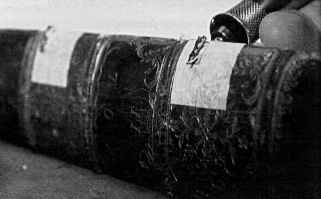 Fig. 2. Board
tacketing: drilling spine.
Fig. 2. Board
tacketing: drilling spine.
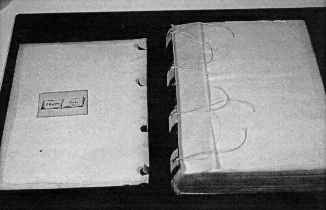 Fig. 3. Board tacketing: board
ready to lace on.
Fig. 3. Board tacketing: board
ready to lace on.
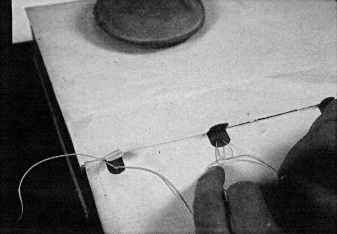 Fig. 4. Board tacketing: lacing
on the board.
Fig. 4. Board tacketing: lacing
on the board.
This technique relies on thread stabbed through the shoulder of the
text block to provide thin laces subsequently used to draw on the
boards (Figs. 2,3,4). It is significantly faster than rebacking or
rebinding and more sympathetic to the character of the original.
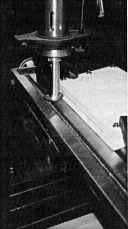 Fig. 5. Board
slotting: board in milling machine. A lengthwise slot is made to
receive the new backing material.
Fig. 5. Board
slotting: board in milling machine. A lengthwise slot is made to
receive the new backing material.
Chris Clarkson developed a technique he calls "board slotting."
It requires the use of a milling machine to slot the board from the
edge in, along most of its length, to receive new rebacking
material. A relatively quick process, it avoids the possibility of
damage to stamped impressions on the surface of the board. A major
drawback with this technique, however, is the cost of a milling
machine, which begins in the $2000 range (Fig. 5).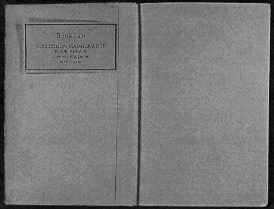 Fig. 6. Collection
maintenance repair: endpaper.
Fig. 6. Collection
maintenance repair: endpaper.
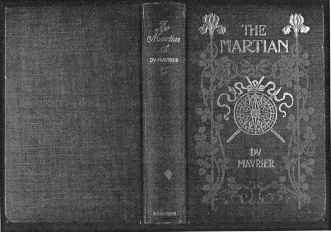 Fig. 7. Collection maintenance
repair: cover.
Fig. 7. Collection maintenance
repair: cover.
Gary Frost and Craig Jensen designed and produced a method of
rebacking that BookLab calls "Collection Maintenance Repair." This
technique provides a relatively inexpensive way to retain original
cloth case bindings with only a minimal impact on the endpapers
(Fig. 6). Its speed of execution and durability recommend this
approach for preserving the integrity of 19th century publishers'
bindings in circulating collections (Fig. 7).
Other innovative approaches to collections conservation include the lapped-case and split board binding.
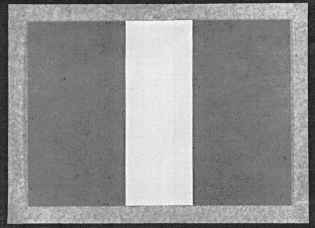 Fig. 8. Lapped case
binding: lining goes across spine and joint areas, from board to
board.
Fig. 8. Lapped case
binding: lining goes across spine and joint areas, from board to
board.
 Fig. 9. Lapped case binding: finished case.
Fig. 9. Lapped case binding: finished case.
Rebinding is appropriate when the original case is too frail to
withstand use, is damaged or missing, and has little aesthetic or
historic significance as determined by the person sorting for
treatment. The lapped-case binding (Fig. 8) is a modification of
the 18th century German Bradel binding. This structure employs a
piece of cloth, Tyvek, or paper which extends from one board to the
other, lining the spine and the joint area. The lining can be
attached to the covering cloth with adhesive or alternatively
allowed to remain unattached and flexible. The advantage of the
lapped-case binding is that it reinforces and strengthens the most
frequently broken areas of the book--;the joints and the endcaps
(Fig. 9).
Split board binding incorporates several features that made 19th century ledger books durable. Gluing the spine's lining material between the boards provides a very sturdy attachment between the cover and the text block. Heavy books such as atlases and unabridged dictionaries require the additional strength that this binding provides.
Computer-generated labels for titling books or boxes can be created
quickly using graphics software and a laser printer. Colored
Japanese or thin Western papers provide sufficient flexibility to
prevent delamination when the spine is flexed. The finished label
is sprayed with an acrylic coating to protect it from abrasion. The
label, which offers an alternative to the usual hand-lettered title,
gives the piece a finished look (Fig. 9). Labels can be created in
batches, an entire book truck at a time, to keep pace with rapid
turnaround. A scanner can be used to reproduce titles with
non-Roman alphabets.
Repair units may construct hundreds of enclosures a year to house brittle material or books from special collections. In some instances, a less expensive alternative to making the enclosures inhouse is to purchase custom-made enclosures.
MicroClimates, from Custom Manufacturing, are die-cut enclosures made to measurements furnished by the customer, from alkaline corrugated board. They take up very little room on the shelf and protect books from abrasion, light and dust. Measurements are taken inhouse, often right in the stacks. The MicroClimates, which arrive flat, can be folded and placed on the books in the stacks, eliminating the need to transport material to the repair unit.
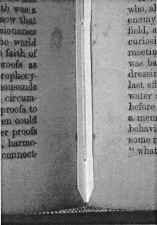 Fig. 10. Pamphlet
binding: free guard.
Fig. 10. Pamphlet
binding: free guard.
Pamphlets require strengthening before circulation. This simple
structure prevents stress to the joint of the binding by sewing the
pamphlet to a reversed cloth hinge which is then glued to the
boards. This method of attachment eliminates the need to tip
endpapers to the first and last leaves of the pamphlet, an all too
common practice that invariably damages the text paper. A free guard
incorporated in this design can minimize stress to the folds of the
section caused by the sewing thread (Fig. 10).
Archival Products manufactures pamphlet binders of its own design that can be stapled or sewn through the center or side of the pamphlet. One version uses a pressure-sensitive cloth strip to cover the spine and hide the staples or sewing. These binders are made from buffered, high density board, 20 mil clear polyester and acrylic-coated C-1 grade book cloth. They are extremely durable, available in several sizes, and provide a cost-effective means of preparing large numbers of pamphlets for permanent storage in the open stacks.
Paperback books, like pamphlets, are vulnerable if placed in the stacks without reinforcement. Budgetary constraints prevent most libraries from commercially binding all new paperback acquisitions. "Cover-ups" are designed as an inexpensive preliminary protection for new paperbacks. They are made from 10 or 15 mil clear polyester, precoated with pressure-sensitive acrylic adhesive. The advantage of this form of shelf preparation is that it adds physical protection to the book for a fraction of the cost of commercial library binding. Should the book subsequently receive damage from high use, the polyester can be replaced with a more durable commercial binding.
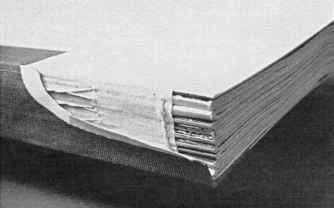 Fig. 11. Temporary
binding: cutaway view.
Fig. 11. Temporary
binding: cutaway view.
Journals are usually sent in groups to the commercial binder for
hard covers. Temporary bindings provide an inexpensive interim
binding for journals when one or more issues of a volume are
missing. When the missing issues have been supplied, this binding is
easily removed and replaced with a commercial library binding.
Should the journal set remain incomplete, this structure will serve
as a permanent binding (Fig. 11).
Some have said that "Book repair is not conservation," and we would agree that repair technicians cannot function as conservators. The conservator's role, however, is critical in transforming book repair operations into a collection-wide conservation approach. The challenge is to employ sound techniques, train employees appropriately, and establish guidelines to ensure that the techniques are applied conservatively and well.
Progress has been made in all these areas of book repair through the efforts of LCCDG members, who debated issues and contributed written documentation and samples. They deserve our thanks and congratulations. We would also like to thank everyone who has lent their good will and support to make quality book repair a reality.